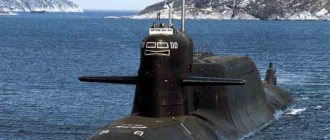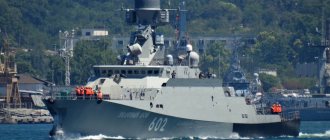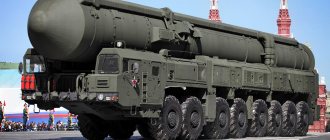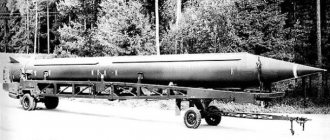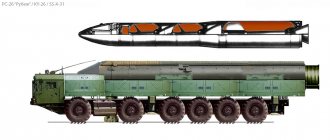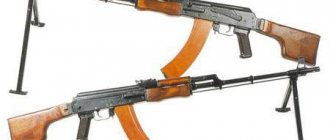Even during the Second World War, raider raids on transport communications and attacks on ships in anchorages remained the destiny of the submarine fleet. But at the end of the 50s, the first submarines capable of carrying and launching ballistic missiles appeared. And they soon became a vital part of the strategic arsenals of world powers.
Naturally, “maritime specifics” forced the development of missiles for SSBNs that differ in design from “land” models. Typically, strategic weapons are not very well known among the people. But in Russia, for some time, all attention was focused on the development and testing of a missile called Bulava.
History of creation
The next round of the Cold War and the arms race led to the start of construction in the United States of new Ohio missile submarines. They were armed with Trident ballistic missiles. The “symmetrical response” of the Soviet Union was to be the R-39 missiles deployed on the Akula submarine cruisers.
However, the deadlines for the development of the new complex were constantly missed, and it was decided to prepare a “backup option.” It included the construction of submarines according to the modernized Project 667 and the development of modernized R-29 missiles for them. As a result, by the mid-80s, both submarine projects and both types of missile systems were adopted.
However, Trident was originally conceived as a transitional weapon. They could have equipped the old Lafayette boats, and in the future the Ohio was going to be re-equipped with more powerful weapons. They became the Trident-2 missiles, which were put into service in 1990.
The USSR did not have time to prepare a response.
More precisely, the development of the modernized Bark complex based on the R-39 began back in 1986, but after the collapse of the Soviet Union, many enterprises that manufactured components for the products ended up abroad. Of course, the funding situation has also worsened. After the third unsuccessful launch of the Bark in 1998, they decided to abandon it, and the development of new rockets was transferred to the Moscow Institute of Thermal Engineering. The project was named R-30 "Bulava".
Care and storage of clubs
Like any sports equipment, clubs require careful care and storage. It’s not for nothing that rhythmic gymnastics with clubs looks especially charming - these unusual objects make a bright accent on the performance, so they must look impeccable.
Medium rubber clubs are the most susceptible to contamination, so they must be thoroughly wiped after practice. Of course, clubs need to be stored in cases. Some clubs manufacturers also produce such cases - for example, venturelli clubs can be easily packed in a case from the same company. However, many domestic companies produce decent covers for clubs for rhythmic gymnastics. When choosing such a case, it is important that it not only protects from dust and dirt, but also prevents scratches.
Ideally suited equipment for rhythmic gymnastics will not only enhance the performance, but will also help the athlete perform all the elements clearly, harmoniously and correctly. Therefore, it is important to study in detail the features of all shells before purchasing.
Design
Not much is known reliably about the structure of the Bulava rocket. It is 3-stage, and most sources agree that the engines of the first 2 stages are solid fuel. But the third stage engine can also be liquid, there is no consensus on this matter. Launch - “dry”, from a sealed transport and launch container.
The striking power of the Bulava is 6 warheads with warheads with a capacity of 150 kilotons. One of the differences of the complex, which is known for sure, is the reduced flight segment during which the main engines operate. Since the active area of the missile is easiest to detect and intercept, reducing it makes it possible to increase the survivability of the weapon. It was also stated that the P-30 could maneuver in the acceleration section. Another important change is the use of adjustable warheads.
A little about the features of the complex
As noted above, the Bulava intercontinental ballistic missile is unique in its kind. This is primarily due to the fact that in combat conditions the missile is capable of withstanding laser fire. It is noteworthy that the inclined launch makes it possible to launch “on the move,” that is, while the nuclear submarine is moving. This will increase the maneuverability of the complex as a whole. By the way, it should be noted that after a series of unsuccessful tests, Solomonov resigned from the post of general director of MIT, but at the same time remained the general designer of the complex. Now let's talk about what facilities the Bulava intercontinental ballistic missile will be used on.
Testing and operation
Serial production of the Bulava began 10 years after the start of its development - in 2008. However, the R-30 has not yet been put into service. Even the complex of tests has not yet been completed. And the tests turned out to be long. Usually, special underwater stands were used to test launches, but they decided to launch the R-30 directly from the submarine.
Thus, the submarine “Dmitry Donskoy” became the “stand”.
For the first launch in 2004, a weight and size prototype of the “product” was used. For the second time, a year later, the real Bulava launched, its training units successfully hitting targets at the Kamchatka training ground. But the fourth, fifth and sixth launches were unsuccessful. The launches made in 2009 also ended in failures.
The Project 955 submarine "Yuri Dolgoruky", which was supposed to become a regular carrier of R-30 missiles, entered service in 2011. Test launches from its board were successful. However, the Bulava continued to be refined, and its launches from the Alexander Nevsky and Vladimir Monomakh submarines were also counted as test launches.
It was only in 2022 that the R-30 was finally put into service. As of 2022, the Bulava is armed with 2 Project 955 boats of the Pacific Fleet and 1 of the Northern Fleet. 2 more submarines are being tested, and 3 are under construction.
[edit] Liberals vs socialists
Liberals got the opportunity to properly troll their opponents, and the latter were able to bring at least some benefit to society by exceeding the brick production plan for a couple of years in advance. Along the way, the top military personnel are shitting with the same bricks, feverishly swapping suppliers, manufacturing plants and themselves so that this thing, born to crawl, learns to fly.
| Translating into Russian, the mechanic Prosha, the turner Stepanych, and the welder Mikola are to blame for the latest failures. Without delving into constructive miscalculations, we can say that all recent test failures are the result of the destruction of industry in Russia. This is the result of the destruction of workers as a class. How many factories have been opened under Putin? How many vocational schools have been opened under Putin? Both were just closing. The trumpeters didn't need them. They didn’t need anything other than resources. We are now reaping the benefits of such a policy. Even Medvedev noticed this. “This is not the right path. The path to nowhere,” but “We will not turn aside and will only go forward!” Who will be responsible for the national shame when third world countries return to us the military equipment they ordered from us because of poor quality? Russia has never experienced such shame, never has the world been so squeamish about our exported equipment. In addition to moral damage, there is also tangible material damage. Who will compensate it? Who will be responsible for the billions thrown away? That's right - mechanic Prosha, turner Stepanych, welder Mikola. In another country, not a vertical one, a parliamentary commission would have been created long ago and those responsible for the damage would have been named long ago. In our country, given the existence of the untouchable caste, the creation of such a commission is completely pointless. Well, the person who never makes mistakes or the famous rocket scientist Seryozha cannot be to blame. And who are the judges? |
Along the way, there is a serious quarrel between the citizens themselves, who also realized that something is wrong with the national defense:
| It is absolutely obvious that we need to stop testing and throw money into the air, and move on to the Sineva rocket - the only rocket that flies in our country |
| Alexander Khramchikhin, political scientist |
Performance characteristics
It is appropriate to compare the R-30 Bulava missile with the American second Trident, in response to which it was created. It is worth remembering that Trident-2 was put into service in 1990 - almost 30 years before the domestic complex.
| R-30 "Bulava" | UGM-133A “Trident-II” | |
| Launch weight, t | 36,8 | 59 |
| Throwing mass, t | 1,15 | 2,8 |
| Combat units | 6x150 ct | 12x100 ct/8x475 ct |
| Maximum range, km | 9300 | 11300/7800 |
| Circular probable deviation | 350 | 120 |
Compared to the American Trident, the P-30 is much lighter, somewhat smaller in size, and inferior in maximum warhead power. At the same time, Trident, equipped with W88 charges, has a shorter range. The main trump card of the Bulava is its increased survivability due to the shortened active flight phase and adjustable warheads.
A large number of unsuccessful test launches at one time caused a negative assessment of the project in the press. In response to this, the developers and the military referred to the fact that the percentage of successful launches of R-29RM missiles was even lower, and the inevitable identification of “childhood diseases” was occurring. After the completion of the tests, the attitude towards the Bulava in the media changed - now the assessment began to reach enthusiastic levels.
It took almost 20 years to develop the Bulava rocket.
The number of Project 955 submarines in service and under construction is eight. At the same time, the Ohio missile carriers, to which the new ships were supposed to be a response, are planned to begin decommissioning at the end of the 2020s.
What will replace them is still unknown. And the question of how quickly the P-30 will require replacement is still open. In any case, the fact that the Bulava reached the point of being put into service can be considered a success.
Description of the Bulava missile
There is no complete information about the technical characteristics of the R-30; it is classified.
The R-30 Bulava missile consists of three solid-fuel stages and a warhead breeding stage. It is believed that the block separation stage operates on liquid fuel, however, this is doubtful, since MIT specializes in solid fuel systems. The rocket uses fifth-generation fuel with high energy efficiency.
The body of the rocket stages is made of composite materials, using high-strength aramid fiber, which allows increasing the pressure in the combustion chamber and obtaining higher impulse.
The first stage engine starts immediately after the rocket leaves the water. The first stage engine operates until the fiftieth second of flight. The second stage engines operate until the ninetieth second of flight, after which the third stage engines turn on. Information on the characteristics and design of the combat unit breeding stage is very scarce.
After passing through the zone of blocking nuclear strikes, the nose fairing is separated. The Bulava missile is equipped with an individually targeted multiple warhead, which consists of six (according to other information, ten) warheads. They have small dimensions, a conical shape and high flight speed. Also at the stage of breeding blocks is a complex for overcoming the enemy’s missile defense, but we know nothing about its structure and characteristics. The warheads of the Bulava missile have a high degree of protection against a nuclear explosion.
There is unverified information about changes in the principle of disengagement of warheads of the Bulava missile. Some sources report that the missile's warheads can maneuver freely, and the developers also claim very high guidance accuracy compared to previous Soviet and Russian missiles. In their opinion, it is this factor that will be able to compensate for the relatively low power of the combat units, as critics of the P-30 have repeatedly pointed out. The deflection radius of warheads is no more than 200 meters. The general designer of the rocket, Solomonov, claims that the Bulava has a higher degree of survivability than rockets of previous generations.
The Bulava control system is astro-radio-inertial. The on-board computer complex processes data received from optical-electronic equipment, which during the flight determines the coordinates of the rocket, studying the location of the stars, and also exchanging information with satellites of the GLONASS information system.
Video about the Bulava rocket
The R-30 "Bulava" missile is launched into flight from a special container installed in the launch silo of a missile carrier, using a powder accumulator. A salvo launch of all ammunition on board the submarine is possible. The launch is carried out both underwater and surface.
According to experts, Russian industry can produce up to 25 R-30 Bulava missiles per year.



